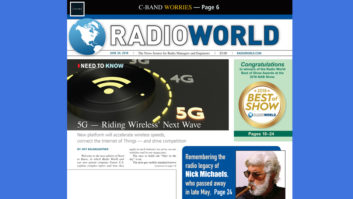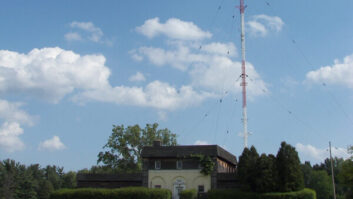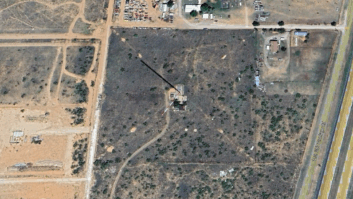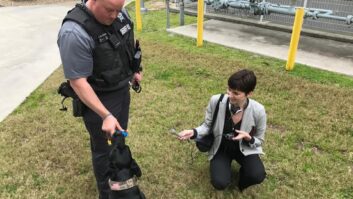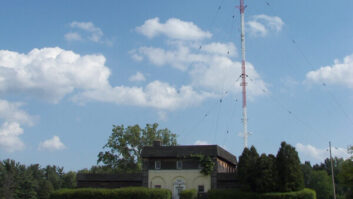The word “broadcasting” really explains what the concept is all about: Casting a net to reach the largest number of listeners possible.
There are times however when the goal is to reach a small audience, or a subset of that larger audience. For that, the term narrowcasting was coined.
In the internet age, scaling a web stream for larger or smaller audiences is a simple matter, but in the analog days, the task was more challenging. One way to narrowcast was with an FM subcarrier, or in the FCC terminology of the day, a Subsidiary Communications Authorization.
This time in Plugging into the Past, let’s look back at the history and technology of FM subcarriers, which inevitably leads to a history of McMartin Industries. We will also check out a McMartin TR-55D FM/SCA tuner that survived a near-death experience.

SUBCARRIER ORIGINS
FM subcarrier technology had its origin during World War II, the outcome of extensive research by the U.S. Navy. After the war, it was sanctioned by the Federal Communications Commission and adopted by FM broadcasters.
Part of the reasoning was that no one was making money off FM broadcasting in the early days, and leasing subcarrier channels offered up a potential revenue stream. The normal SCA channels of 67 and 92 kHz were “invisible” to consumer radios and could only be received with special tuners such as the TR-55.
Much of the early research and development work on FM subcarriers was done by Leonard Hedlund, who joined McMartin Industries in 1957 and served as vice president for research and development for many years. One of Hedlund’s more innovative projects was for Market Information, who wanted not only to transmit stock quotations by voice over SCA channels, but also to have that information digitally coded for display on a video monitor. He also wrote numerous brochures and white papers about FM subcarriers.
While subcarriers could be used to reach any small audience within a station’s coverage area, the technology became synonymous with Muzak throughout most of the 1960s and ’70s. While it was derisively termed “elevator music,” its bland, easy listening material was ubiquitous in retail and office settings of the day.
The audio signal for a subcarrier service typically arrived at the station’s FM transmitter site via an equalized telephone line. From there, it usually went through some form of audio processing, and on to the station’s subcarrier generator and then to the exciter. Stations broadcasting subcarriers had to have an FCC type-approved SCA monitor and take regular meter readings of subcarrier frequency, injection level and modulation.
At the receive site, a rooftop antenna was always installed, as FM subcarriers are even more sensitive to multipath degradation than stereo. The installers usually carried an assortment of high-gain, cut-to-frequency, gamma-matched 72-ohm three- and five-element Yagi antennas in their trucks. Cut-to-frequency antennas usually yielded a gain of about 20 dB over broadband FM devices. For extreme reception issues, a stacking harness was available so that two or more antennas could be deployed.
Getting a solid, multipath-free signal in urban areas was no easy task. Often there wasn’t a direct line of sight to the transmitter, and a clean reflected signal was the best hope. Also, the lowest multipath signal didn’t always arrive in the horizontal plane, and a rotation adapter was often used to tilt the antenna for best performance.
The coax run from antenna to receiver was kept as short as possible, and the receiver was usually located in a utility closet. The audio out was connected to an amplifier which fed a 70-volt distribution system, which usually ended in a series of ceiling-mounted speakers.
While Muzak was the largest consumer of FM subcarriers, there were others. The Physician’s Radio Network leased subcarriers in large cities to distribute medical news and commercials for medical professionals, while Market Information Inc. broadcast commodity quotations for brokers, grain elevators and feed lots.

There were also countless regional and local users of SCA, including reading services for the blind, which often had an arrangement to use the subcarrier of the local public radio station. Ethnic groups in large cities used them for foreign language broadcasts. The low cost of desktop receivers combined with the simplicity of operations were advantages for these populations.
By the early to mid 1980s, the use of subcarriers began to decline, as direct satellite broadcast operations were usually more affordable. Reading services and ethnic broadcasters held on for a while longer, but many eventually switched to streaming media. Satellite technology also helped to expand a new genre of radio, storecasting, where large retail chains could have their own channels.
MCMARTIN INDUSTRIES
It’s difficult to recount a history of FM subcarriers without examining McMartin Industries.
Entrepreneur Ray B. McMartin graduated from MIT with a Bachelor of Science degree in business and engineering administration. He then worked in market research, sales engineering and marketing for several major corporations. He also served as a first lieutenant in the U.S. Air Force.
In 1956, Ray McMartin founded Continental Manufacturing to build consumer electronics devices. He shifted gears in 1962, renamed the company McMartin Industries Inc. and started in the broadcast business. The first products were subcarrier receivers, followed by FM monitors. The company soon evolved into a turnkey manufacturer of all types of broadcast equipment.
Operations grew rapidly until the company split into four divisions. In addition to Broadcast Products, the SCA division manufactured all types of subcarrier equipment. Commercial and Engineered Sound built equipment that was engineered into building sound systems and incorporated into various commercial sound applications. Private Label manufactured equipment for OEM accounts including Muzak, 3-M, Physicians Radio Network, Dow Jones, Hughes Aircraft, SCI, RCA Service Company, Western Electric, A.D.T. and Collins Radio.

Sales began at a modest $600,000 in 1963, hit the $1 million mark in 1973, and peaked at around $10 million by 1979. At that point, the company occupied a 55,000-square-foot research and manufacturing facility located on seven acres in Omaha. McMartin had 150 employees during the peak years.
The year 1979 marked a turning point in McMartin Industries’ history. Interest rates skyrocketed, and the company had a difficult time paying back its loans. At the same time, the economy faltered, and sales of subcarrier equipment also declined, as many providers switched to satellite delivery. While all this was going on, sales expenses for broadcast equipment had increased. The end came when the bank took over, closed the company and liquidated its assets at auction.
After McMartin Industries went under, there were two attempts to revive the company. Ray McMartin launched McMartin International in Gunnison, Colo., which closed after a year. In 1983, Jerry Martin and John Miller tried to revive the company as McMartin Inc., based in Council Bluffs, Iowa, but that closed in 1985.
Today, sales and service of McMartin equipment continues through Goodrich Enterprises, run by former McMartin Industries Director of Engineering Charlie Goodrich. The company sells rebuilt McMartin AM and FM transmitters and high-power transmitting tubes, as well as servicing McMartin SCA and background music receivers, as well as modulation monitors.
LOOKING INSIDE
Our own McMartin TR-55D was discarded in the mid-1980s by a local public address and sound contractor, who had installed subcarrier equipment in the 1970s.
The service tag said “power transformer zonked,” and they weren’t kidding. When the top cover was removed, the inside was completely black. The large hole in the side of the power transformer, combined with the bits of molten metal embedded in the side of the chassis suggested that the life of this receiver came to a violent end as the result of a lightning strike. Not having a need for a subcarrier receiver, it was tossed in the attic for the next 30 years.
Repairing several FMR-1D receivers for a station in 2012 rekindled my interest in vintage McMartin RF gear from the ’70s. It became a challenge to see if this TR-55 could be brought back from the dead after so many years. Lightning damaged equipment is always a gamble to fix because even semiconductors that survive the surge can be weakened and fail at a later date — or not.
I needed a quick strategy to assess the condition of the receiver before investing a lot of time and energy in parts and labor. The schematic indicated that the TR-55 ran off a 13-volt DC supply, so the bench supply was connected in its place. When it was powered up, voltages were checked on the receiver against those indicated on the schematic, and they generally agreed. It was safe to assume this TR-55 was in working condition, and that the lightning strike had destroyed the transformer and nothing more.
Next, all the electrolytics and one zener were replaced, and a crystal for the local NPR station was installed. The moment of truth came when the receiver was tuned according to the manual, an analog voltmeter was connected to the indicated test points as the oscillator, doubler, antenna, RF, mixer and doubler coils were peaked. Success of sorts came, as the main channel of the NPR station was loud and clear. Sadly, the radio reading service was no longer in operation, so only faint white noise was audible from the subcarrier jack.
Pictured with the TR-55D is a McMartin A-72-PA indoor preamp FM antenna. It consisted of a tuned helix element that fed an FET preamp, and could be powered by most McMartin SCA receivers of the day, by batteries, or with an external power supply. Since they were intended for the subcarrier market, few were sighted around radio stations.
